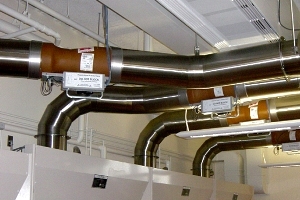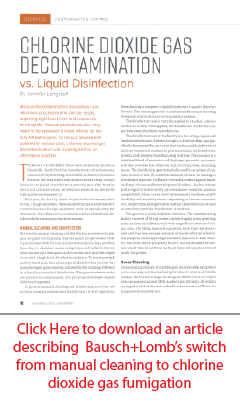ClorDiSys offers decontamination services to provide a sterilization level fumigation of any enclosed space
at your facility. This biodecontamination can take place for a variety of applications, including:
ClorDiSys' chlorine dioxide gas technology
allows for a complete decontamination of your facility, with minimal equipment and minimal downtime.
Gaseous systems provide the ability to achieve a complete distribution and thorough penetration to each and every surface
within your facility, including visible and invisible cracks and crevices. Chlorine dioxide is safe on materials and leaves
no post treatment residuals.
 Rooms/Partial Facilities Case Study:
A 13,500 ft3 pharmaceutical production suite consisting of various production and processing equipment was
decontaminated with chlorine dioxide gas after a contamination was discovered. Even after thorough cleaning and liquid
decontamination, a persistent salmonella problem could not be eradicated. ClorDiSys was able to fumigate the facility utilizing
chlorine dioxide gas and eliminate the organisms while providing sporicidal kill of Biological Indicators (comprised of bacillus
atrophaeus spores) placed throughout the facility to ensure the process was successful. |
Complete Facilities Case Study:
An HIV and Hepatitis research facility totaling 345,300 ft3 across multiple floors was decontaminated with chlorine
dioxide gas during the decommissioning of the facility prior to its renovation. ClorDiSys was able to fumigate the facility
utilizing chlorine dioxide gas and provide a 6-log sporicidal kill of Biological Indicators (comprised of Bacillus atrophaeus spores)
placed throughout the facility to ensure the process was successful and that the facility was safe for future use.
 |

Beta Lactam Inactivation Case Study:
A 31,000 ft3 laboratory within a beta lactam manufacturing facility was treated with chlorine dioxide gas to
inactivate the various beta lactams found within the lab prior to its renovation. Chlorine dioxide gas was used due to
its ability to reach all surfaces and allow for the safe renovation and reuse of the laboratory and its equipment afterward. |
HVAC Ductwork / HEPA Housings Case Study:
An HVAC system handling a BSL-2 and BSL-3 HIV and Hepatitis C research laboratory
was decontaminated with chlorine dioxide gas prior to its renovation. This allowed for the renovation crew to work
in a safe environment without having to wear personal protective equipment (PPE) while performing renovation work.
This allowed for a quicker and more cost-effective renovation of the space. Chlorine dioxide gas was used due to its
ability to reach all surfaces and distribute throughout the entire length of ductwork without condensing or leaving a residue.
 |

Processing Equipment
Rooms and processing equipment can be decontaminated with chlorine dioxide gas prior
to use or on a routine basis. Chlorine dioxide gas can also be used in contamination response to eliminate any contamination
present and quickly return rooms and equipment back to production readiness. Typically all equipment in a food production facility
is compatible with chlorine dioxide gas. By using a gas, all surfaces including cracks and crevices are contacted, allowing for
the complete decontamination of millions of cubic feet of volume. |
Piping
Piping and vessels can be decontaminated with chlorine dioxide gas prior to use or on a routine basis to ensure sterility of
the products inside. Chlorine dioxide gas can also be used in contamination response to eliminate any contamination present.
This can replace steam and harsh chemicals saving time and reducing costs.
 |
 Isolators
Chlorine dioxide gas decontamination of isolators is quick, residue free, and cycle development free. Isolators can be
decontaminated in under an hour whether they are empty or full of components. |









